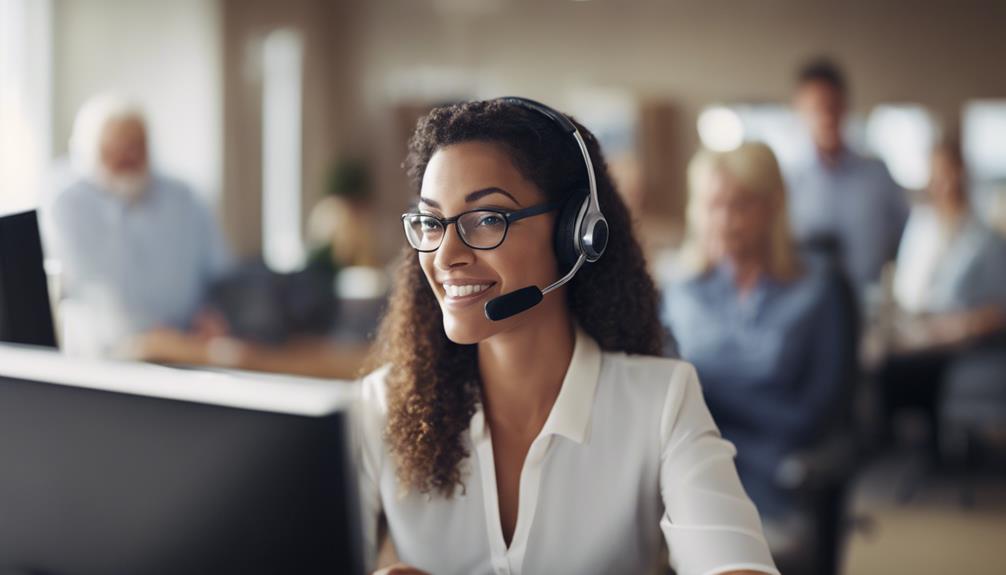Annuities
Comparing Fees and Features of Leading Annuity Providers
Begin your journey into the world of annuities by exploring key factors like fees and features that can significantly impact your financial decisions.

When comparing fees and features of leading annuity providers, key factors to take into account include administrative fees under 0.30%, investment expenses below 2.5%, surrender charges, mortality and expense risk charges between 0.50% and 2%, commissions, and interest rates for fixed, variable, and indexed annuities. Evaluating policy options, customer service quality, investment features, risk tolerance alignment, and selection tips is important for sound financial choices. Explore further into these aspects to make informed decisions aligned with your financial goals.
Key Takeaways
- Administrative fees should be below 0.30% or range from $50 to $100.
- Investment expense ratios should stay below 2.5% for annuities.
- Surrender charges vary based on contract terms and decrease annually.
- Mortality and expense risk charges fluctuate between 0.50% to 2%.
- Commissions are typically under 10% and based on contract features.
Annuity Providers Overview

An overview of annuity providers in the financial industry reveals a diverse landscape of established companies with distinctive offerings and histories. AIG, founded in 1919, stands out as a leading annuity provider with a long-standing presence in the market. Its extensive experience in insurance and annuities has solidified its reputation for reliability and stability.
In contrast, Athene, established in 2009, has focused exclusively on offering annuity products, showcasing a more specialized approach in meeting the needs of customers seeking annuity solutions.
These providers, along with industry stalwarts like MassMutual, Prudential, and Transamerica, each bring unique features and strengths to the table. MassMutual, founded in 1851, is renowned for its wide range of annuity products tailored to diverse needs, while Prudential, established in 1875, is known for its innovative retirement solutions.
Transamerica, founded in 1928, not only offers exclusive indices but also actively supports charitable causes through donations, adding a philanthropic element to its financial services portfolio.
Fee Structures Comparison

When comparing annuity providers, understanding the various fee structures is essential. This includes administrative fees, investment expense ratios, surrender charges, mortality and expense risk charges, and commissions.
Fee Types Overview
Comparing the fee structures of different annuity providers reveals key distinctions in administrative fees, investment expense ratios, surrender charges, mortality and expense risk charges, and commissions.
Administrative Annual Fees can be either a percentage of the contract value or a flat rate, typically falling below 0.30% or ranging from $50 to $100.
Investment Expense Ratios represent the annual cost of underlying investments, usually staying below 2.5% for annuities.
Surrender Charges are applied to early withdrawals before scheduled payments, with fees that vary based on contract terms and decrease annually.
Mortality and Expense Risk Charges (M&E) for annuities can fluctuate between 0.50% to 2% of the contract value.
Commissions, typically under 10% for annuities, are paid to selling insurance agents based on contract features.
Fee Comparison Chart
In evaluating fee structures among different annuity providers, a detailed comparison chart can illuminate the varying costs associated with administrative annual fees, investment expense ratios, surrender charges, mortality and expense risk charges, and commissions.
Administrative annual fees are typically below 0.30% or between $50 to $100, charged as a percentage of the contract value or a flat rate.
Investment expense ratios usually fall below 2.5%, representing the annual cost of holding underlying investments.
Surrender charges apply to early withdrawals and decrease annually based on contract terms.
Mortality and expense risk charges range from 0.50% to 2% of the contract value, covering insurance risks.
Commissions, paid to selling insurance agents, vary based on contract features but generally stay below 10%.
Interest Rates Analysis

Annuity interest rates play a pivotal role in determining the growth and eventual payouts of annuity investments. Fixed annuity interest rates typically range from 1.5% to 3.5% during the savings phase, providing a stable and predictable return for investors. On the other hand, variable annuity interest rates fluctuate based on the performance of underlying investments, offering the potential for higher returns but also carrying more risk. Indexed annuity rates are linked to market indices, often with caps and participation rates, providing a balance between fixed and variable options.
To illustrate the differences further, let's compare the features of fixed, variable, and indexed annuities:
| Annuity Type | Interest Rates |
|---|---|
| Fixed Annuity | 1.5% – 3.5% |
| Variable Annuity | Varies based on performance of underlying investments |
| Indexed Annuity | Tied to market indices with caps and participation rates |
Understanding how these interest rates operate is essential for effective financial planning, especially during high-interest rate periods to maximize returns and achieve long-term financial goals.
Policy Options Evaluation

How do the various policy options fare when evaluated based on factors such as administrative annual fees, investment expense ratios, surrender charges, mortality and expense risk charges, and commissions? When appraising policy options among annuity providers, several key financial metrics come into play for a thorough evaluation:
- Administrative Annual Fees: These fees vary from below 0.30% to flat-rate fees of $50 to $100, with potential waivers for larger contracts. Understanding the structure of these fees is vital for cost analysis.
- Investment Expense Ratios: Typically staying below 2.5%, these ratios reflect the annual cost of owning underlying investments within the annuity. Lower ratios can lead to higher returns over time.
- Surrender Charges and M&E Risk Charges: Surrender charges apply to early withdrawals, decreasing annually over time. Mortality and expense risk charges, ranging from 0.50% to 2% of the contract value, impact the overall cost of the annuity. Evaluating these charges is crucial in understanding the financial implications of policy options.
Customer Service Assessment

When evaluating annuity providers, an important aspect to examine is their performance in terms of customer service excellence. MassMutual's low customer complaint ratio reflects their dedication to providing excellent customer service.
Fidelity Investments' high capital ratio indicates strong financial strength and stability, instilling confidence in their ability to meet obligations. Athene's impressive annual premiums sold demonstrate a high level of customer trust, while Allianz Life's inclusion of no-charge riders adds value to their annuity products.
Pacific Life's focus on customer satisfaction further enhances their reputation for exceptional service. Evaluating customer service is essential as it directly impacts the overall experience and satisfaction of annuity holders.
Providers that prioritize customer needs, offer value-added services, and have a solid financial standing tend to excel in this competitive market, fostering long-term relationships built on trust and reliability.
Investment Features Examination

Examining the investment features of annuities reveals key financial considerations that impact the overall cost and performance of these financial products. When evaluating annuities, investors should pay close attention to:
- Expense Ratios: Typically below 2.5%, expense ratios reflect the annual cost of owning underlying investments within the annuity.
- Surrender Charges: Fees that may apply to early withdrawals before scheduled payments, decreasing annually based on contract terms.
- Mortality and Expense Risk Charges (M&E): Ranging from 0.50% to 2% of the contract value, these charges impact overall costs and should be carefully examined.
Other important factors to consider include commissions paid to selling insurance agents, administrative fees (often a percentage of the contract value or a flat rate), and the implications of early withdrawals based on contract terms. Understanding these investment features is important for making informed decisions regarding annuities.
Risk Tolerance Consideration

Risk tolerance plays a pivotal role in the selection process of an annuity, guiding individuals towards products aligning with their preferences for either safety or growth potential. When considering annuities, it is essential to assess your risk tolerance to determine the most suitable option for achieving your financial goals.
Annuity providers offer various fee structures and features tailored to different risk profiles, ranging from fixed annuities offering stability to variable annuities providing growth potential based on market performance, and indexed annuities offering a mix of both. Understanding your risk tolerance can help you decide whether a fixed, variable, or indexed annuity aligns with your investment preferences.
Some companies may charge higher fees for more aggressive investment options, catering to individuals with higher risk tolerance levels. Evaluating the balance between fees and potential returns is critical in matching your risk tolerance with an annuity provider's offerings.
Selection Tips for Investors

For investors seeking to make informed decisions when selecting annuity providers, thorough comparison of key factors such as administrative fees, investment expenses, surrender charges, mortality and expense risk charges, and commission rates is essential.
When evaluating different annuity products, here are three important tips to keep in mind:
- Compare annual administrative fees: Look for fees that are typically below 0.30% or fall within the range of $50 to $100 charged by leading annuity providers.
- Assess investment expense ratios: Aim for ratios below 2.5% to minimize costs associated with the annuity's underlying investments.
- Evaluate surrender charges: Consider charges that apply to early withdrawals and decrease over time with contract terms. This can help in managing fees effectively and avoiding significant penalties.
Frequently Asked Questions
Which Annuity Has the Highest Fees and Expenses?
When considering annuities, identifying the one with the highest fees and expenses requires a thorough examination of various cost components. Annuities with numerous fees, such as high administrative expenses, investment expense ratios, surrender charges for early withdrawals, and mortality and expense risk charges (M&E), could collectively contribute to a significant financial burden for the investor.
Careful scrutiny of these factors across different providers is essential to pinpoint the annuity with the highest overall costs.
Which Company Is Best for Annuities?
When considering which company is best for annuities, it is essential to assess factors such as:
- Financial stability
- Product offerings
- Customer service reputation
- Fees
Analyzing these aspects can help individuals make an informed decision that aligns with their financial goals and risk tolerance.
Conducting thorough research, seeking advice from independent agents, and comparing multiple providers can assist in finding the most suitable annuity provider tailored to individual needs.
What Annuities Have the Lowest Fees?
When evaluating annuities for low fees, it is crucial to take into account various factors beyond just the cost. Look for providers that offer competitive fee structures while also providing strong features and benefits that align with your financial goals.
Guarantee transparency in fee disclosures and compare the totality of each annuity's offerings to make an informed decision that balances fees with value. This approach helps you select annuities that offer the lowest fees without compromising on quality or benefits.
Which Company Has the Best Annuity Rates?
When seeking the annuity provider with the best rates, it's essential to compare offerings from reputable companies. Some examples include:
- Massachusetts Mutual Life Insurance
- USAA Life Insurance
- New York Life Insurance
- TIAA-CREF Life Insurance
- Allianz Life Insurance
Evaluating the rates, financial strength, and any additional features offered by these providers can help determine which company aligns best with your financial goals and risk tolerance.
Which Annuity Providers Have the Best Fees and Features Compared to Others?
When looking for the top annuity providers reviewed, it’s important to consider the fees and features they offer compared to others. Some providers may prioritize low fees, while others may offer more robust features. Researching and comparing different providers can help you find the best option for your financial needs.
Conclusion
To sum up, when comparing fees and features of leading annuity providers, it is crucial for investors to carefully consider all aspects of each provider's offerings.
One interesting statistic to note is that the average annual fee for variable annuities is approximately 2.3%, which can have a substantial impact on long-term returns.
By conducting thorough research and analysis, investors can make informed decisions that align with their financial goals and risk tolerance levels.
Annuities
Balancing Inflation Risks and Annuity Returns: A Strategic Approach
Get insights on strategically balancing inflation risks and annuity returns, essential for optimizing investments and safeguarding your financial future.

To balance inflation risks with annuity returns strategically, consider allocating assets wisely. Annuities' fixed payments might lose value due to inflation, but cost-of-living adjustments can help. Diversifying with equities, commodities, and real estate can hedge against inflation. Indexed annuities offer protection. Keep in mind that fixed income assets face challenges in high-inflation scenarios. Understanding unique investment characteristics is key to crafting effective strategies. Further exploration can provide detailed insights into optimizing annuity returns and safeguarding against inflation risks.
Key Takeaways
- Utilize cost-of-living adjustments in annuities for inflation protection.
- Diversify annuity investments across asset classes for optimal returns.
- Consider indexed annuities as a hedge against inflation risks.
- Incorporate partial annuity strategies to reduce risk exposure.
- Combine annuities with other income sources for a stable retirement plan.
Understanding Inflation Risks and Annuities

In the domain of retirement planning, understanding the inherent inflation risks associated with annuities is paramount for ensuring long-term financial security.
Annuities, as a form of fixed income investment, can provide protected lifetime income, but they are susceptible to erosion in real value due to inflation. The risk arises because annuities typically offer a fixed payment amount, which may lose purchasing power over time as prices increase.
In times of rising inflation, the real value of these fixed payments diminishes, impacting the retiree's standard of living. Additionally, changes in interest rates can also affect annuity returns, as they are closely tied to the performance of underlying investments.
To mitigate inflation risk, retirees can opt for annuities that come with cost-of-living adjustments to combat the erosive effects of inflation. By understanding how inflation risk interacts with annuities and considering strategies like partial annuity plans or combining annuities with other income sources, retirees can better navigate the complexities of retirement income planning in the face of inflation challenges.
Asset Allocation Strategies for Inflation

Asset allocation in the face of inflation involves strategic considerations such as inflation hedge strategies and diversification for protection. Equities and commodities respond differently to inflation, necessitating a balanced approach to asset allocation.
Inflation Hedge Strategies
Amidst the complexities of financial markets, crafting effective inflation hedge strategies through asset allocation requires a keen understanding of the unique characteristics of various investment options. Equities and commodities are known for their effectiveness in hedging against inflation, with equities reacting strongly to growth surprises and commodities being more sensitive to inflationary pressures.
Fixed income assets, such as fixed annuities, may face challenges in high-inflation scenarios due to their vulnerability to inflation's negative impact. Real estate stands out as a potential inflation hedge, with its value often appreciating in line with positive growth surprises and economic conditions.
Indexed annuities, linked to specific indexes, can also offer protection against inflation, making them a valuable asset in inflation hedge strategies.
Diversification for Protection
Crafting a well-diversified portfolio is essential for safeguarding against the erosive effects of inflation on purchasing power. Allocating investments across various asset classes like equities, fixed income, real estate, commodities, and annuities can help mitigate inflation risks. Equities offer growth potential, fixed income provides stability, real estate acts as an inflation hedge, commodities protect against rising prices, and annuities offer guaranteed income.
Benefits of Annuities in Retirement Planning

In retirement planning, one can leverage the benefits of annuities to secure a protected lifetime income that adjusts for inflation. Annuities offer a valuable solution in an inflationary environment, providing retirees with the assurance of cost-of-living adjustments to maintain the purchasing power of their income over time. This feature helps mitigate the risks posed by rising prices and guarantees that retirees can sustain their lifestyle throughout their retirement years.
Additionally, annuities with fixed, level payments can help manage market volatility, offering a stable financial foundation amidst unpredictable economic conditions. By incorporating annuities into a retirement portfolio, individuals can allocate their other assets towards investments with higher growth potential while still providing a reliable source of income.
Furthermore, the use of partial annuity strategies can further enhance retirement income planning by reducing risk and optimizing withdrawal rates, aligning more closely with retirees' spending needs and ensuring financial security throughout retirement.
Impact of Economic Scenarios on Portfolios

The Impact of Economic Scenarios on Portfolios can be significant, influencing asset allocations and investment strategies in response to changing market conditions. Different economic scenarios, such as varying levels of interest rates and inflation, play an important role in determining the best composition of portfolios. Asset allocation is key in managing these scenarios effectively, ensuring that investments are positioned to mitigate risks and capitalize on opportunities.
To visualize the impact of economic scenarios on portfolios, consider the following table:
| Economic Scenario | Asset Allocation Strategy |
|---|---|
| High Interest Rates | Increase in fixed-income investments for higher yields. Decrease in equities due to higher borrowing costs. |
| Low Inflation | Emphasis on equities for growth opportunities. Reduction in inflation-hedging assets like TIPS. |
| Growth Surprises | Shift towards equities to benefit from positive economic growth. Real estate allocation increases as an effective inflation hedge. |
| Diversification | Hedge funds play a role in diversifying the portfolio, adjusting based on shifts in other asset classes. |
This table illustrates how asset allocations can be adjusted in response to economic scenarios, highlighting the importance of strategic decision-making in portfolio management.
Maximizing Annuity Returns Through Diversification

Diversifying annuities across different asset classes can help minimize risk exposure and enhance long-term stability.
By combining various types of annuities, investors can optimize their portfolio for growth potential, income stability, and protection against market fluctuations.
Maximizing annuity returns through diversification involves a strategic approach to allocating funds that align with individual financial goals and risk tolerance levels.
Diversifying Asset Classes
Maximizing annuity returns through diversification entails strategically allocating assets across various classes within portfolios. Diversifying asset classes within annuities offers several benefits:
- Long-Term Growth Potential: By including equities and other growth-oriented investments, annuity holders can capitalize on the potential for long-term capital appreciation.
- Inflation Protection: Including commodities in the asset mix can help hedge against inflationary pressures, maintaining the purchasing power of the annuity over time.
- Diversification: Spreading investments across different sectors and asset classes reduces concentration risk and enhances overall portfolio resilience.
- Asset Allocation: Thoughtful allocation of assets can optimize returns, mitigate risk, and provide stability in changing market conditions.
Strategic diversification in annuity portfolios is key to achieving a balanced and robust investment strategy.
Minimizing Risk Exposure
To enhance annuity returns through diversification, a strategic allocation of assets across various classes within portfolios is imperative.
Diversification within annuities can help minimize risk exposure by spreading investments across different asset classes such as variable annuities and indexed annuities.
By incorporating a mix of fixed, variable, indexed, and income annuities in annuity portfolios, investors can optimize risk-adjusted returns.
Balancing inflation risks and annuity returns requires careful investment management through strategic diversification to capture growth opportunities while managing downside risks.
Allocating assets across various types of annuities provides stable income streams and potential for growth in different market conditions.
Retirees can tailor their portfolios to meet specific risk tolerance levels and financial goals by diversifying annuity investments effectively.
Enhancing Long-Term Stability
With a well-structured approach to asset allocation within annuities, long-term stability and enhanced returns can be achieved through strategic diversification. Diversification within income annuities can help manage inflation risks and optimize returns over time.
By investing in diversified portfolios, retirees can spread risk effectively and potentially increase their overall financial stability. Strategic asset allocation within annuities provides a balanced approach to managing market fluctuations and uncertainties, ultimately aiming for long-term stability.
This approach allows retirees to access a mix of assets that can offer higher potential returns while mitigating risks associated with market volatility. By incorporating various investment instruments, retirees can create a more resilient financial plan that adapts to changing economic conditions.
Adapting Portfolio Allocations to Economic Changes

During periods of economic flux, successful investors strategically adjust portfolio allocations to navigate changing market conditions effectively.
When considering variable annuities offered by insurance companies, which are regulated by the SEC, investors must be aware of the capped upside potential.
In response to economic changes, portfolio adjustments become important to optimize returns and manage risks. Equities, being influenced by growth surprises, may need rebalancing depending on the direction of growth and inflation surprises.
On the other hand, commodities, sensitive to inflation changes, play a significant role in adapting portfolio allocations due to their response to inflation dynamics.
In high-inflation scenarios, fixed income assets might require significant adjustments compared to other asset classes, as they are negatively impacted by inflation.
Therefore, investors need to carefully monitor economic changes and make informed decisions regarding their portfolio allocations to mitigate risks and capitalize on potential opportunities.
Mitigating Risks With Inflation-Sensitive Assets

How do inflation-sensitive assets contribute to risk mitigation in investment portfolios?
In times of high inflation, these assets play an important role in balancing the overall risk exposure. Consider the following:
- Hedge against inflation: Assets like commodities tend to perform well during periods of high inflation, providing a hedge against the erosion of purchasing power.
- Diversification benefits: Including inflation-sensitive assets, such as TIPS (Treasury Inflation-Protected Securities), can enhance portfolio diversification and reduce overall risk.
- Impact of interest rates: Federal Reserve policies and interest rate movements can greatly affect inflation-sensitive assets, making them important considerations for risk management.
- Role in insurance portfolios: Insurance companies often utilize inflation-sensitive assets to match their long-term liabilities, providing stability and predictability in returns.
Strategies for Optimizing Annuity Returns

When it comes to retirement investment strategies, maximizing annuity returns is an important factor in protecting against inflation risks and ensuring long-term financial stability for retirees.
Annuities with cost-of-living adjustments play a vital role in combating inflation by increasing payments over time, effectively providing inflation protection. Additionally, implementing partial annuity strategies can help reduce risk and lower withdrawal rates, further enhancing inflation protection for retirees.
Income annuities offering level payments present a precise match to retirees' spending needs, aiding in managing inflation risks effectively. Retirees facing income shortfalls relative to their spending goals can consider purchasing additional annuities to bolster their inflation protection strategies.
Furthermore, creating a holistic retirement income plan by combining annuities with other income sources can address inflation concerns comprehensively, ensuring a more stable financial future during retirement. By leveraging these various annuity strategies, retirees can optimize their annuity returns while safeguarding their retirement income against the erosive effects of inflation.
Frequently Asked Questions
How Do Annuities Deal With Inflation?
Annuities address inflation by offering options like cost-of-living adjustments or level payments. These features help mitigate the impact of inflation on retirees' purchasing power.
Annuities with level payments can provide stability amid market volatility in inflationary environments. Partial annuity strategies can effectively reduce risk and lower withdrawal rates for retirees concerned about inflation.
What Is an Annuity Strategy?
An annuity strategy aims to guarantee a reliable income stream during retirement by utilizing annuities. These strategies are designed to provide retirees with financial security by offering protection against market volatility, longevity risks, and inflation.
By incorporating features such as cost-of-living adjustments, annuity strategies help retirees maintain their purchasing power over time.
What Is the Best Way to Beat Inflation Saving or Investing?
Investing typically offers a better chance of beating inflation compared to saving alone. By investing in assets with growth potential and diversifying one's portfolio, individuals can potentially counter the erosive effects of inflation on savings.
Strategic investing, tailored towards inflation protection, can enhance the likelihood of maintaining purchasing power in the long term. Saving, while essential, may not keep pace with inflation's impact, making investing a more effective strategy for beating inflation.
What Is a Total Return Strategy?
A total return strategy is an investment approach that aims to maximize returns by considering all sources of income, including dividends, interest, and capital gains. By focusing on both income and capital appreciation, this strategy seeks to enhance overall portfolio performance.
It involves reinvesting earnings for long-term growth potential while diversifying income sources to mitigate market volatility and inflation risks. This approach allows investors to adapt to changing economic conditions and maintain a balanced investment approach.
How Does Balancing Inflation Risks Apply to Annuity Decisions?
When considering annuity decisions, it’s essential to understand the trade-off between lifetime vs period certain payouts. Balancing inflation risks is crucial as it impacts the value of future payments. Opting for lifetime payouts provides guaranteed income but may be affected by inflation over time, while period certain payouts offer fixed payments for a set duration.
Conclusion
In managing the delicate balance between inflation risks and annuity returns, strategic asset allocation and diversification are key. By adapting portfolio allocations to economic changes and incorporating inflation-sensitive assets, investors can mitigate risks and optimize annuity returns.
The benefits of annuities in retirement planning cannot be understated, offering a valuable tool for long-term financial security. With a thoughtful approach and a focus on maximizing returns, investors can navigate the complexities of inflation and annuities with confidence.
Annuities
The Role of Indexed Annuities in Protecting Against Inflation
With the ability to combat inflation and provide growth potential, indexed annuities play a crucial role in securing retirement income – discover how!

Indexed annuities are a valuable strategy to safeguard against inflation's impact on retirement income. They offer a combination of guaranteed minimum returns and potential interest tied to market indexes. These annuities aid in combating the erosion of purchasing power caused by rising costs. By understanding market index performance connections and utilizing downside protection mechanisms, investors can achieve a balance between growth and security. Inflation's effects can be mitigated through strategic planning with indexed annuities. Leveraging their unique features for long-term financial goals is essential for maintaining a steady income stream. Indexed annuities remain a key tool for those aiming to secure their financial future.
Key Takeaways
- Indexed annuities safeguard retirement income from inflation erosion.
- Inflation protection features preserve purchasing power over time.
- Market index-linked returns offer growth potential with downside protection.
- Indexed annuities mitigate risks of income shortfalls due to inflation.
- Strategic use of indexed annuities shields income against inflation's erosive effects.
Understanding Indexed Annuities

Indexed annuities, also known as equity-indexed annuities or registered index-linked annuities, are financial products that offer a mix of guaranteed minimum returns and potential interest based on market indexes. These annuities, including Fixed Index Annuities, serve as a tool for investors seeking an Inflation Hedge. By linking returns to market indexes like the S&P 500, indexed annuities provide the potential for higher returns than traditional fixed annuities, making them attractive for investors looking to outpace inflation.
Insurance Regulations play a vital role in governing indexed annuities. State insurance commissioners regulate these products, ensuring consumer protection and compliance with specific standards. Unlike securities, which fall under the oversight of the SEC and FINRA, indexed annuities primarily adhere to insurance regulations. This regulatory framework aims to safeguard investors' interests, maintain market stability, and uphold transparency within the insurance industry. Understanding these regulations is essential for investors considering indexed annuities as part of their financial portfolio.
Benefits of Inflation Protection

Indexed annuities with inflation protection offer an essential shield against the impact of rising prices, aiding in long-term financial security.
These annuities help mitigate the risk of inflation eroding retirement income by providing a mechanism for potential growth tied to market indexes.
Inflation Risk Mitigation
Retirees seeking to safeguard their purchasing power against the effects of inflation can benefit greatly from annuities with inflation protection features. Indexed annuities with inflation protection offer a significant way to mitigate inflation risk and preserve retirement income.
These annuities provide a valuable hedge against inflation by offering potential growth linked to market indexes. By ensuring that their retirement income keeps pace with rising living costs, individuals can better address the challenge of increasing expenses over time.
With indexed annuities, retirees have the opportunity to benefit from potential market gains while having protection against inflation risks, enhancing their financial security in retirement. Inflation-protected indexed annuities play an important role in helping individuals maintain their standard of living despite inflationary pressures.
Long-Term Financial Security
To secure their financial well-being in the long term, individuals can leverage annuities with inflation protection features, ensuring the preservation of their purchasing power amidst economic fluctuations.
Indexed annuities play a vital role in providing long-term financial security, particularly in retirement planning. By safeguarding against the erosive effects of inflation, these annuities help maintain the real value of retirement savings over time.
The unique structure of indexed annuities allows for returns linked to market indexes, potentially outpacing inflation rates. This combination of growth potential and downside protection makes indexed annuities a valuable tool for individuals looking to secure their financial future during retirement.
With a balanced approach to growth and stability, indexed annuities offer a reliable means of combating inflation and ensuring a stable income stream in retirement.
Market Index Performance Connection

Indexed annuities, particularly EIAs and RILAs, are linked to market indexes such as the S&P 500, impacting their returns. EIAs guarantee a minimum rate of return alongside potential market index-linked returns, while RILAs offer downside protection without a guaranteed minimum interest rate.
Understanding how market index performance influences indexed annuity returns is essential for comprehending their growth potential and limitations as part of an inflation protection strategy.
Index Performance Impact
Linked to the performance of selected market indexes like the S&P 500, indexed annuities' returns may be influenced by various factors such as participation rates, fees, and caps. The rate of return on indexed annuities can differ from the index's positive return due to these contractual limitations. Participation rates determine how much of the index's growth is credited to the annuity.
Caps restrict the maximum interest that can be earned, impacting potential returns. Fees can also reduce the overall rate of return. Understanding how these factors interact with index performance is essential for investors considering indexed annuities.
Inflation Protection Strategy
Implementing an effective inflation protection strategy within indexed annuities involves a thoughtful consideration of how market index performance influences potential returns. Indexed annuities, such as fixed and indexed annuities, are directly linked to the performance of market indexes.
While fixed indexed annuities (FIAs) offer a guaranteed minimum interest rate alongside potential returns tied to market index performance, Registered Index-Linked Annuities (RILAs) provide downside protection through buffers or floors without a guaranteed minimum interest rate. The rate of return in these annuities is dependent on how the chosen market index performs.
Factors like caps, participation rates, and fees in FIAs can impact the actual return compared to the positive performance of the index. Understanding these connections is essential in crafting a detailed inflation protection strategy within indexed annuities.
Downside Protection Mechanisms

When considering investment options like Registered Index-Linked Annuities (RILAs), it is essential to understand the protective mechanisms against downside risks that these products offer.
Unlike Equity-Indexed Annuities (EIAs), RILAs do not guarantee a minimum interest rate. However, they provide downside protection through selected buffers or floors, which can help limit risk exposure for investors. This feature is particularly valuable in times of market volatility or economic uncertainty.
By offering a level of security against market downturns, RILAs aim to strike a balance between potential returns and downside protection. Investors looking for a financial product that can provide some stability while still offering growth potential may find RILAs to be a suitable option.
Understanding how these downside protection mechanisms work is vital for making informed investment decisions, especially in the context of managing inflation risks and preserving purchasing power over the long term.
Impact on Purchasing Power

To safeguard against the erosion of retirees' purchasing power caused by inflation, it is imperative to take into account the long-term impact on their savings and retirement income. Inflation gradually diminishes the value of money, reducing what retirees can buy with their savings over time. Failure to consider inflation in retirement planning can lead to income shortfalls, impacting the quality of life for retirees. The U.S. has experienced an average inflation rate of 3.22% from 1913 to 2013, emphasizing the constant threat it poses to retirees' purchasing power. Furthermore, extreme cases of hyperinflation, such as in Brazil in 1990, can rapidly erode retirees' financial security. Planning for inflation is crucial to ensure that retirees' retirement savings remain sufficient and sustainable throughout their retirement years.
| Inflation Impact | Purchasing Power | Retirement Savings |
|---|---|---|
| Gradual erosion of value | Decreases over time | Need to outpace inflation |
| Income shortfalls | Reduced lifestyle | Adequate planning is vital |
| Constant threat | Long-term impact | Protection strategies required |
| Hyperinflation risks | Rapid devastation | Financial security at stake |
Balance Between Growth and Security

Achieving a harmonious equilibrium between investment growth and financial security is a key consideration for retirees when exploring indexed annuities. These financial products, such as Equity-Indexed Annuities (EIAs) and Registered Index-Linked Annuities (RILAs), offer a unique balance by providing a guaranteed minimum interest rate alongside the potential for market index-linked returns. This balance is important in retirement planning, where individuals seek growth opportunities while also safeguarding their savings.
By incorporating features that calculate returns based on market index performance, indexed annuities serve as a hedge against inflation, which is essential for maintaining purchasing power in retirement.
Indexed annuities, often categorized as fixed annuities, not only offer downside protection but also the potential for growth, making them an attractive option for retirees looking to secure a reliable income stream during their post-employment years. The ability to balance growth with security positions these annuities as valuable tools in addressing the financial challenges posed by inflation, thus playing a significant role in long-term retirement planning strategies.
Mitigating Inflation's Effects

In retirement planning, the strategic utilization of indexed annuities can effectively mitigate the detrimental impacts of inflation on savings and purchasing power. By offering growth potential linked to market indexes, indexed annuities provide an important tool in safeguarding income against the erosive effects of inflation.
These financial products strike a balance between downside protection and growth opportunities, making them an essential component in long-term financial planning. Insurance companies offer indexed annuities like EIAs and RILAs, which incorporate strategies to shield retirement savings from inflation risks.
RILAs, for instance, use buffers or floors to limit downside risk while still enabling investment growth in inflationary environments. Through a combination of guaranteed minimum returns and market index performance, indexed annuities can help retirees sustain their purchasing power amidst fluctuating inflation rates.
When considering options for financial planning in retirement, indexed annuities play a significant role in mitigating the effects of inflation on income and overall financial stability.
Role in Long-Term Financial Planning

How can indexed annuities strategically contribute to long-term financial planning goals while balancing growth potential and downside protection?
Indexed annuities, offered by insurance companies, present a unique opportunity for investors seeking to safeguard their financial future. These annuities provide a guaranteed minimum interest rate, shielding investors from market downturns while still allowing for potential growth tied to selected market indexes.
By incorporating an income rider, indexed annuities can guarantee a steady income stream, making them an attractive option for retirees looking to combat the impact of inflation on their purchasing power. The rate of return in indexed annuities is closely linked to the performance of market indexes, offering a chance to outpace the inflation rate over time.
While withdrawal accessibility may be restricted by surrender charges and early withdrawal penalties, the long-term benefits of indexed annuities make them a valuable component of a thorough financial plan. By leveraging the unique features of indexed annuities, investors can achieve a fine balance between growth potential and downside protection, securing a more stable financial future.
Frequently Asked Questions
What Is the Purpose of an Indexed Annuity?
The purpose of an indexed annuity is to provide investors with a financial product that combines principal protection and growth potential.
These annuities offer a guaranteed minimum interest rate alongside the opportunity to earn interest linked to a market index.
How Are Indexed Annuities Protected Against the Downside Risk of Traditional Equity Investments?
Indexed annuities protect against the downside risk of traditional equity investments by incorporating features like floors and buffers. Floors establish a minimum return, shielding against negative index performance, while buffers limit losses in market downturns, allowing for potential gains.
Unlike direct equity investments, these mechanisms offer a level of security and downside protection, making indexed annuities an attractive option for risk-averse investors seeking to mitigate market volatility.
What Does Suze Orman Think About Index Annuities?
Suze Orman has expressed skepticism about index annuities, warning investors about their complexity, surrender charges, and limited fund accessibility. She advises thorough understanding of contract terms to align with investment goals and risk tolerance.
While index annuities offer potential returns between fixed and variable annuities, Orman emphasizes the need for careful evaluation. Seeking advice from financial experts on these products is vital, reflecting the importance of regulatory oversight comprehension.
What Is the Most Common Indexing Method Used in Indexed Annuities?
The most common indexing method used in indexed annuities is tracking market indexes like the S&P 500. These annuities calculate returns based on the performance of selected market indexes, influencing the growth of the annuity.
– How Do Indexed Annuities Compare to Annuities with Built-In Inflation Adjustments in Protecting Against Inflation?
Indexed annuities and annuities with inflation adjustments both aim to protect against inflation. However, indexed annuities offer potential for higher returns by linking interest to stock market performance, while annuities with inflation adjustments provide a guaranteed increase in payments over time to keep pace with rising cost of living.
Conclusion
To sum up, indexed annuities play a vital role in protecting against inflation by offering a balance between growth and security. They provide a mechanism for safeguarding purchasing power and mitigating the effects of inflation over time.
By connecting market index performance and incorporating downside protection mechanisms, indexed annuities symbolize a strategic tool in long-term financial planning. Their ability to offer inflation protection makes them a valuable asset in preserving and growing wealth in a volatile economic landscape.
Annuities
Understanding Cost of Living Adjustments in Annuities
Leverage the power of Cost of Living Adjustments (COLAs) in annuities to protect your retirement income against inflation and secure your financial future.

Understanding Cost of Living Adjustments (COLAs) in annuities is essential for retirees. COLAs guarantee that annuity payments rise with inflation, safeguarding purchasing power. These adjustments protect against the impact of rising prices, maintaining a retiree's standard of living over time. Annuities without COLAs risk losing real purchasing power. Factors like actuarial evaluations and inflation projections influence COLA decisions. Balancing immediate income needs with long-term security is key. While adding COLAs may reduce initial payments, they offer stability. Choosing the right type of adjustment is crucial. Evaluating long-term financial security considering COLAs is essential. The impact of COLAs on purchasing power is significant.
Key Takeaways
- COLAs protect annuity payments from losing value to inflation.
- They ensure retirees' standard of living remains stable.
- COLAs offer increased purchasing power over time.
- Actuarial evaluations help determine COLA impact on income.
- Choosing the right COLA adjustments is vital for financial security.
Importance of COLAs in Annuities

In the domain of retirement planning, the significance of Cost of Living Adjustments (COLAs) in annuities cannot be emphasized enough. COLAs play an important role in guaranteeing that annuity payments keep pace with inflation, thereby safeguarding the purchasing power of retirees over time. By incorporating COLAs into annuity contracts, individuals receive inflation protection, allowing them to maintain their standard of living without worrying about the eroding effects of rising prices on their financial security.
Annuity providers utilize various methods, such as Consumer Price Index (CPI) adjustments, to determine the COLAs for their contracts. Typically, these adjustments are made annually, with any changes reflected in the subsequent annuity payments to account for the increased cost of living. This feature is essential for retirees who rely on fixed income sources to cover their daily expenses, as it ensures that their money retains its value and sustains their quality of life throughout retirement. Ultimately, COLAs serve as an important mechanism in retirement planning, offering stability and peace of mind by preserving the real purchasing power of annuity payments.
Benefits of Cost-of-Living Adjustments

Cost-of-living adjustments in annuities provide increased purchasing power and protection against inflation.
By adjusting payouts based on the cost-of-living index, annuitants can maintain their standard of living despite rising prices.
These benefits guarantee financial stability and security in retirement by safeguarding against the eroding effects of inflation.
Increased Purchasing Power
Ensuring annuity payouts maintain their purchasing power over time, cost-of-living adjustments play an essential role in safeguarding retirees against the erosion of inflation. These adjustments, often referred to as cost-of-living adjustment (COLA), are particularly beneficial for those relying on income annuities for their monthly income.
By incorporating COLAs, annuity providers offer a solution that addresses the necessity for increases in payouts to match the rising cost of living. This mechanism helps retirees manage their expenses effectively, ensuring that their monthly income remains sufficient to cover their needs as prices increase.
With increased purchasing power, retirees can maintain their standard of living without worrying about the diminishing value of their annuity payments.
Inflation Protection
By implementing adjustments tied to inflation rates, annuities equipped with cost-of-living adjustments offer retirees a reliable safeguard against the erosive effects of rising prices on their income stability. This inflation protection guarantees that retirees can maintain their purchasing power and cover essential expenses throughout their retirement.
Benefits of cost-of-living adjustments include:
- Securing a stable income source in retirement
- Guaranteeing the ability to afford daily necessities
- Shielding against the diminishing value of money over time
- Providing a reliable financial safety net for the future
- Enhancing overall financial security and peace of mind
Factors Influencing COLA Decisions

When considering cost-of-living adjustments (COLAs) for annuities, various factors come into play, such as the desired level of inflation protection and the type of COLA selected. Actuarial evaluations are essential in evaluating how COLAs impact annuity payments and benefits over time.
Decisions regarding COLA riders should also consider the implications on Required Minimum Distributions (RMDs) and their long-term financial effects.
COLA Decision Factors
Factors influencing the decision to add a Cost of Living Adjustment (COLA) rider to an annuity include considerations such as longevity, inflation projections, and the initial income sacrifice. Actuarial analysis plays an important role in evaluating the impact of COLA riders, gauging how long it takes for the increased payments to offset the initial reduction.
The economic sense of adding a COLA rider depends on factors like life expectancy, potential income growth, and individual financial objectives. It's essential to remember that COLA riders may not break even if the annuitant's life expectancy is not met. Additionally, one must consider how future withdrawals may affect adjustments, especially in scenarios where unscheduled withdrawals could hinder the intended benefits.
- Uncertainty surrounding future financial needs
- Balancing immediate income needs with long-term financial security
- The emotional impact of financial stability
- Protecting against unforeseen economic challenges
- Ensuring peace of mind for yourself and your loved ones
Influence on Annuities
Annuities with Cost of Living Adjustments (COLA) are influenced by various factors, such as the Consumer Price Index (CPI) or government securities yields, shaping the adjustments made to payouts over time. Providers may offer a COLA rider as part of the annuity contract, impacting initial payments and ensuring income increases in line with inflation.
The decisions around prorated COLA in annuities can have a profound impact on the stability of retirement income by helping payouts keep pace with rising costs. These adjustments, based on specific indices like the CPI, are vital for retirees relying on annuities for financial security.
Factors such as longevity, inflation projections, and limitations set by the provider all play a role in determining the effectiveness of cost-of-living adjustments in annuities.
Evaluating COLA Impact on Income

In evaluating the impact of Cost of Living Adjustments (COLA) on income from annuities, careful consideration must be given to the trade-off between initial monthly income and potential future benefits. When deciding on whether to include a COLA rider in your annuity for retirement income, an actuarial analysis becomes essential. This analysis helps determine the value of sacrificing some initial income for the potential long-term benefits that COLA increases can provide. The breakeven point, which signifies when the benefits of the COLA rider start outweighing the initial income reduction, is dependent on factors such as life expectancy and the rate of increase. It is important to note that it may take some time for the monthly income from an annuity with a COLA rider to equal that of a non-COLA annuity. Therefore, the economic sense of adding a COLA rider hinges on factors like longevity and reaching the breakeven point.
- Uncertainty surrounding future expenses can make choosing a COLA rider a challenging decision.
- Balancing current financial needs with potential future inflation risks requires careful deliberation.
- The emotional reassurance of a COLA rider's protection against rising costs can provide peace of mind.
- Longevity considerations play a significant role in the effectiveness of a COLA rider over time.
- Understanding the trade-off between initial income reduction and future income potential is essential for making a well-informed decision.
Limitations of Adding COLAs

Adding a cost-of-living rider to an annuity can pose challenges due to potential limitations that may impact the effectiveness of the rider in providing inflation protection. One limitation is that the initial annuity payment may be reduced when a cost-of-living adjustment (COLA) is included, affecting short-term income levels.
Unscheduled withdrawals can also hinder the adjustments made by the COLA rider, potentially disrupting the intended inflation protection benefits. In high inflation scenarios, even with a COLA rider, annuity payouts may not keep pace with rising living costs, leading to a shortfall in income.
Providers may impose restrictions on the frequency or size of adjustments, further impacting the rider's ability to provide adequate inflation protection. While a cost-of-living rider offers better inflation protection, there is still a risk that inflation could outstrip the adjustments made, leaving annuitants vulnerable to the erosive effects of inflation on their purchasing power.
Understanding Inflation Protection

Ensuring financial stability in retirement necessitates a thorough understanding of how inflation protection mechanisms safeguard annuity payments against diminishing purchasing power over time. One vital aspect of this protection is the cost-of-living adjustment (COLA) feature, which helps annuitants combat the erosive effects of inflation on their income amount.
Here are some key points to take into account:
- The Bureau of Labor Statistics monitors inflation rates, influencing COLA calculations.
- FERS annuitants rely on COLAs to guarantee their annuity keeps pace with inflation.
- COLAs offer peace of mind by ensuring annual increases in annuity payments.
- Without inflation protection, retirees risk a decline in the real value of their income over time.
- Choosing an annuity with robust inflation protection can provide long-term financial security.
Understanding how inflation protection works within annuities is essential for retirees looking to maintain their purchasing power and financial well-being throughout their retirement years.
Making Informed COLA Choices

To make informed decisions regarding cost-of-living adjustments (COLAs) in annuities, retirees must carefully evaluate how these adjustments can impact the long-term sustainability of their income.
COLAs can play an important role in ensuring that retirees' monthly annuity payments keep pace with inflation over time, similar to how Social Security benefits include cost-of-living adjustments.
By opting for a COLA rider, retirees can secure a more predictable lifetime income that adjusts to economic changes. It's vital to understand that while choosing a COLA rider may initially result in lower monthly payments, the long-term benefits of having a steadily increasing income can outweigh this drawback.
Different types of COLA adjustments, such as level percent increases or adjustments based on the Consumer Price Index (CPI), can influence how much your income grows throughout retirement.
Assessing Long-Term Financial Security

Evaluating long-term financial security in annuities involves examining the sustainability of income against inflationary pressures. This evaluation is vital for annuitants who retired and rely on Income Annuities to support their livelihood throughout retirement. To guarantee a reliable financial future, considering a COLA rider with a fixed percent increase can enhance financial security significantly.
- COLA adjustments protect against the eroding effects of inflation on retirement income.
- Income Annuities with COLA riders provide stability by keeping pace with rising costs.
- Forecasting how COLA adjustments can impact purchasing power is essential in evaluating long-term financial security.
- Choosing the right percent increase in COLA riders is crucial for maintaining financial stability in retirement.
- Annuities equipped with cost-of-living adjustments offer peace of mind by safeguarding against inflationary pressures.
Frequently Asked Questions
What Is the Cost-Of-Living Adjustment in an Annuity?
A cost-of-living adjustment (COLA) in an annuity is an increase in payments intended to counteract the effects of inflation. This adjustment helps guarantee that the purchasing power of annuity payouts remains relatively stable over time.
Typically tied to factors like the Consumer Price Index (CPI), COLA provisions can offer fixed annual percentage increases or be linked to changes in the CPI.
Annuities with COLA features provide a safeguard against the diminishing impact of inflation on income.
What Is the Cola Rider on an Annuity?
A Cost-of-Living Adjustment (COLA) rider on an annuity is a feature that increases payouts over time to counter the effects of inflation. This rider guarantees that the annuitant's income keeps up with rising living costs, safeguarding their purchasing power throughout retirement.
How Do Annuities Adjust With Inflation?
Annuities safeguard against inflation by incorporating Cost of Living Adjustments (COLAs) into their payout structure. These adjustments can be based on fixed percentage increases or tied to the Consumer Price Index (CPI) for more accurate tracking of living costs.
COLAs guarantee that annuity payments keep pace with rising expenses over time, mitigating the risk of inflation eroding the real value of fixed annuity payouts.
Do Annuities Include Cola?
Yes, annuities can include Cost-of-Living Adjustments (COLA) to safeguard against the impact of inflation. COLAs provide annual payment increases to match rising living costs, preserving the annuitant's purchasing power. These adjustments are typically linked to indices like the Consumer Price Index (CPI) or fixed percentage increments.
While opting for a COLA rider may lead to lower initial payments, it guarantees long-term protection against inflation's erosive effects on annuity payments.
How Do Cost of Living Adjustments Impact Annuity Payout Options?
Cost of living adjustments can significantly impact understanding annuity payout options. These adjustments help annuity payouts keep up with inflation, ensuring the money maintains its purchasing power throughout retirement. When considering annuity payout options, it’s crucial to factor in potential cost of living adjustments to ensure financial security in the long term.
Conclusion
In summary, understanding cost of living adjustments in annuities is essential for ensuring financial security in retirement. While COLAs can provide inflation protection and increase income over time, there are limitations to take into account.
One potential objection may be the added cost of incorporating COLAs, which could impact overall returns on investment. However, by carefully evaluating the benefits and drawbacks of COLAs, individuals can make informed decisions to safeguard their long-term financial well-being.
-

 Gold IRA3 months ago
Gold IRA3 months agoRegal Assets Lawsuit Update: Key Facts Explained
-

 Annuities3 months ago
Annuities3 months agoPros and Cons of Annuities: A Comprehensive Guide
-

 Annuities3 months ago
Annuities3 months agoUnderstanding Qualified Vs. Non-Qualified Annuities and Their Benefits
-

 Annuities3 months ago
Annuities3 months agoUnderstanding Cost of Living Adjustments in Annuities
-

 Annuities3 months ago
Annuities3 months agoBalancing Inflation Risks and Annuity Returns: A Strategic Approach
-

 Annuities3 months ago
Annuities3 months agoThe Role of Indexed Annuities in Protecting Against Inflation
-

 Gold IRA3 months ago
Gold IRA3 months agoComprehensive Provident Metals Review 2024
-

 Bitcoin IRA3 months ago
Bitcoin IRA3 months agoRetirement Planning in the Age of Crypto: Assessing the Risks and Rewards of Bitcoin IRAs










